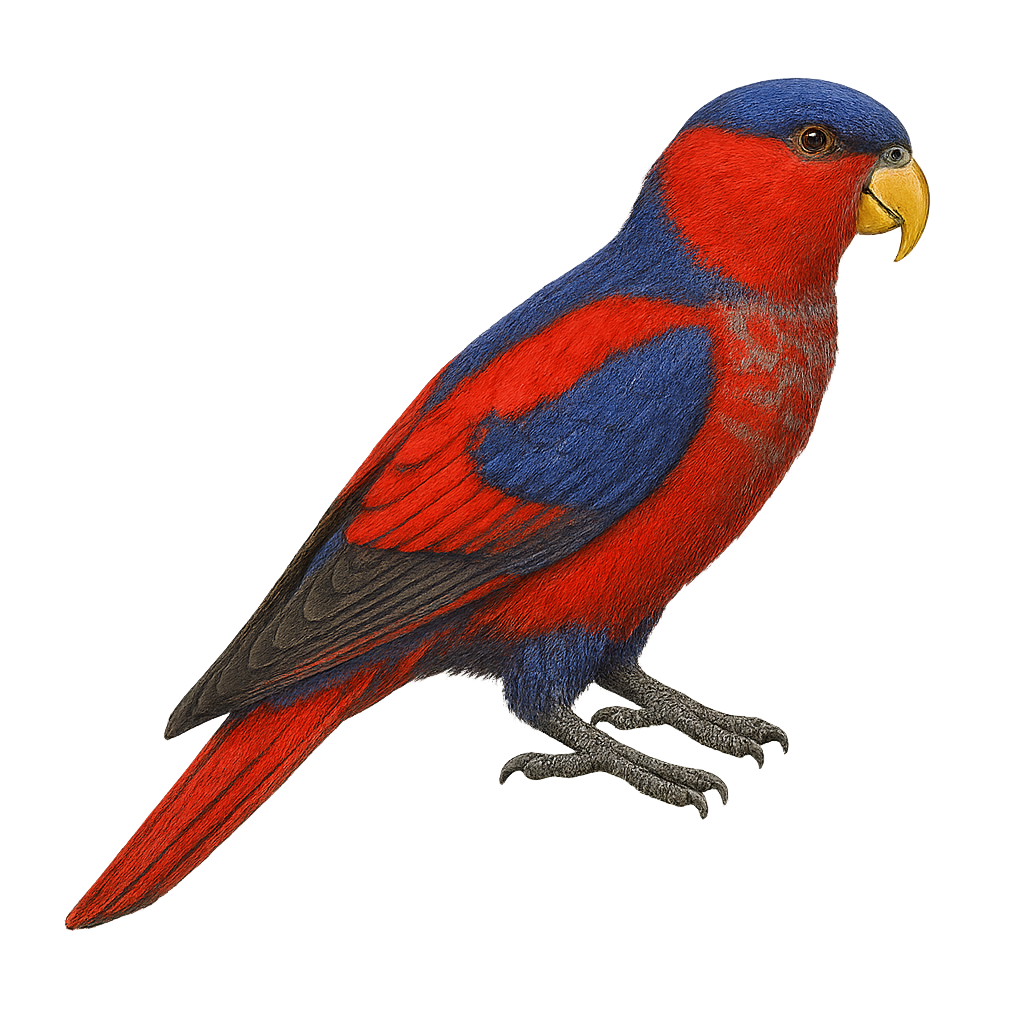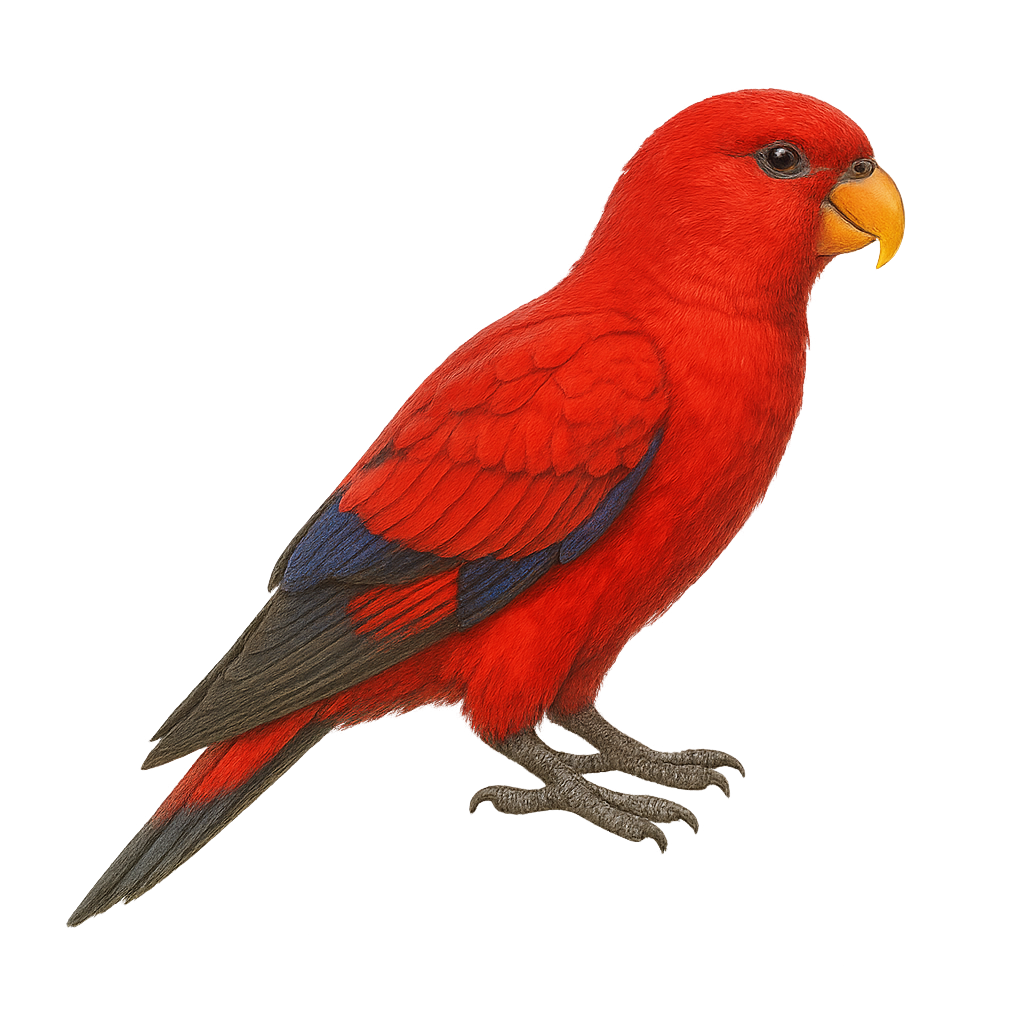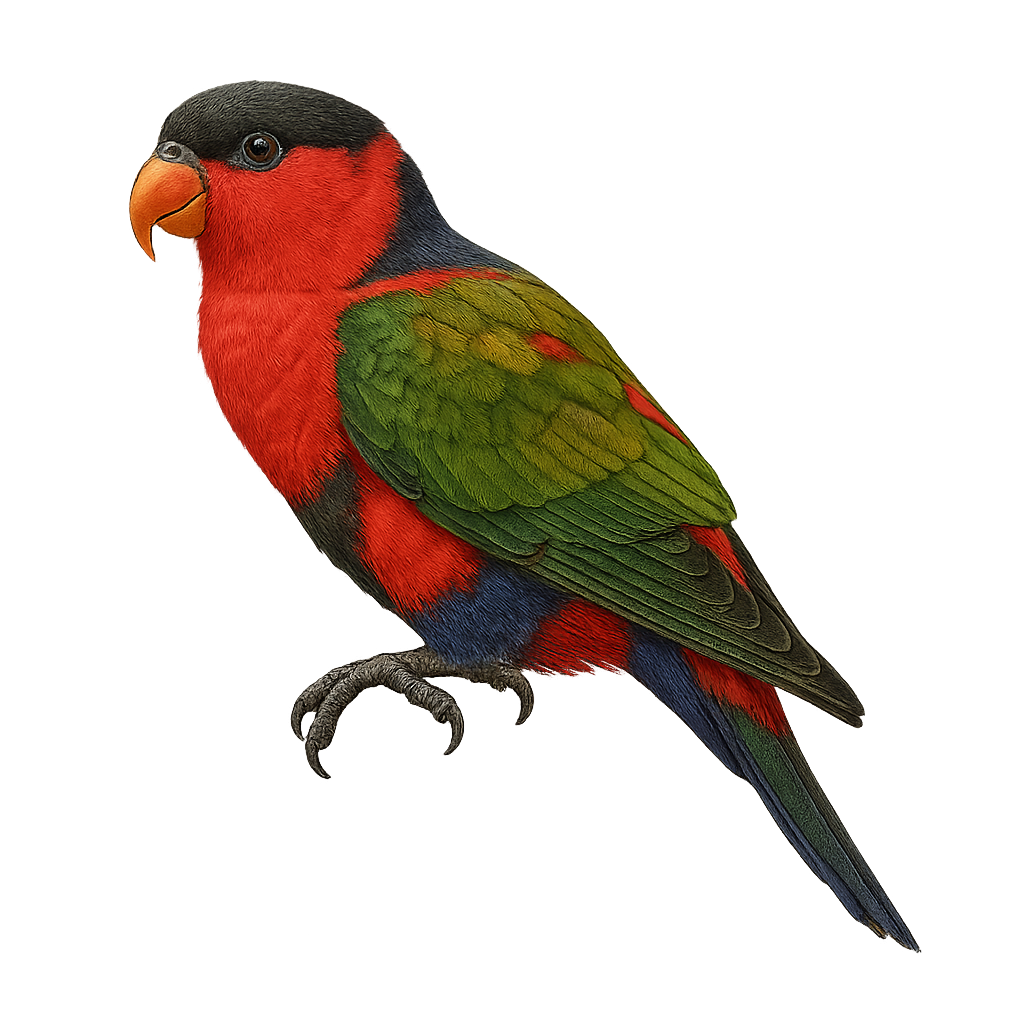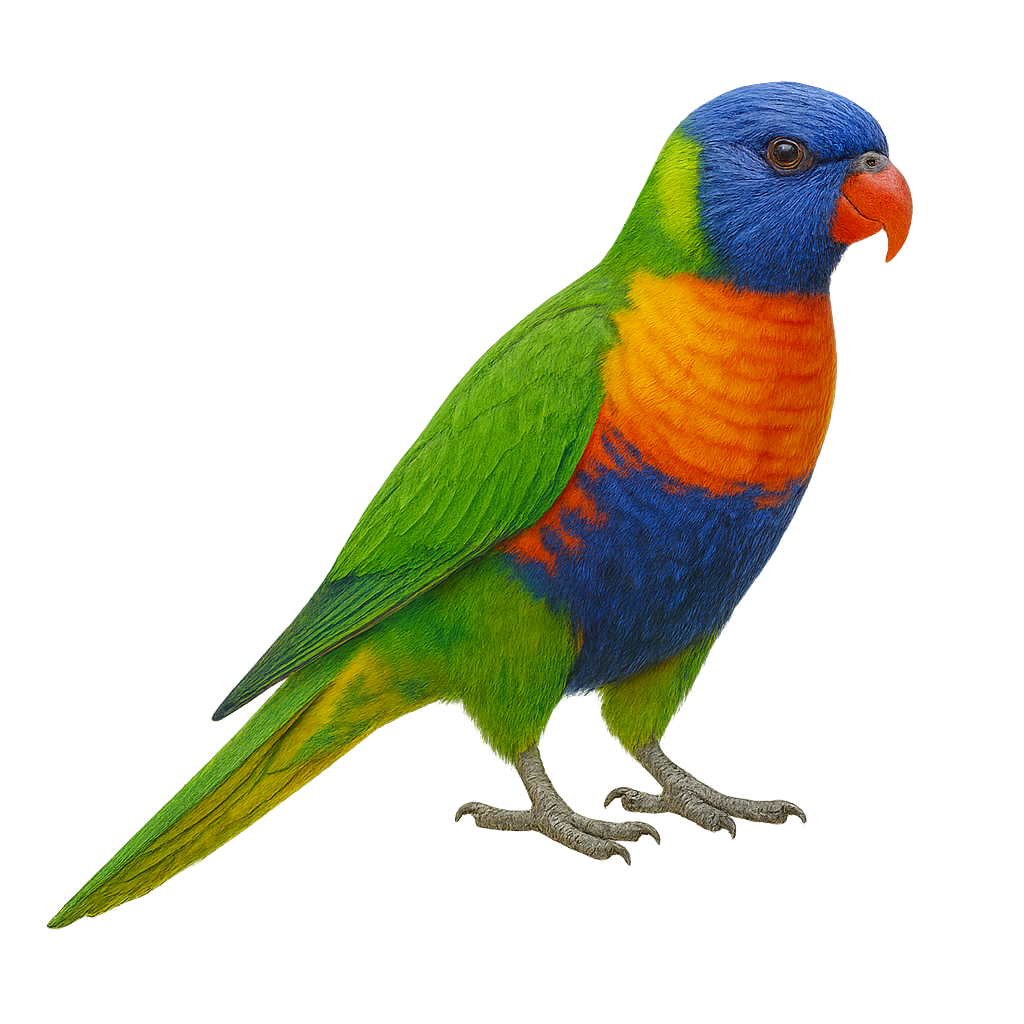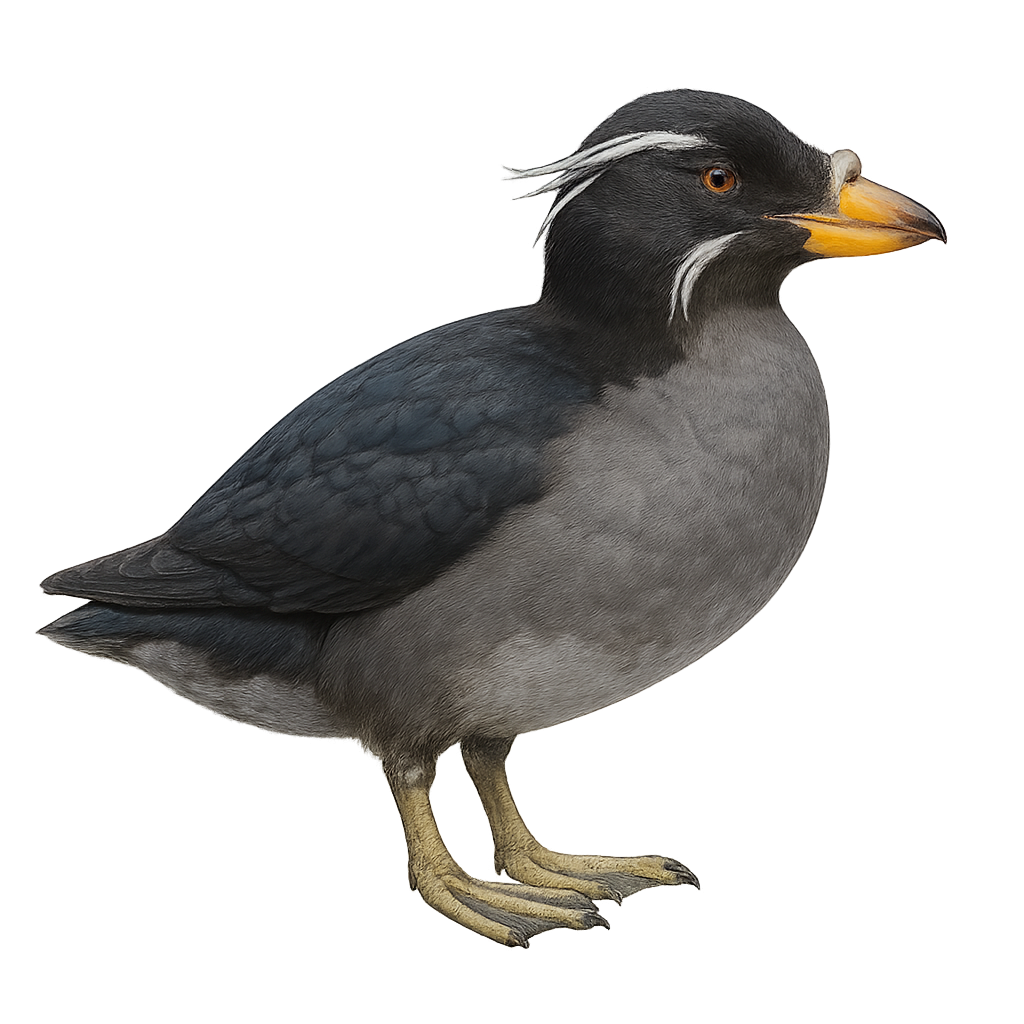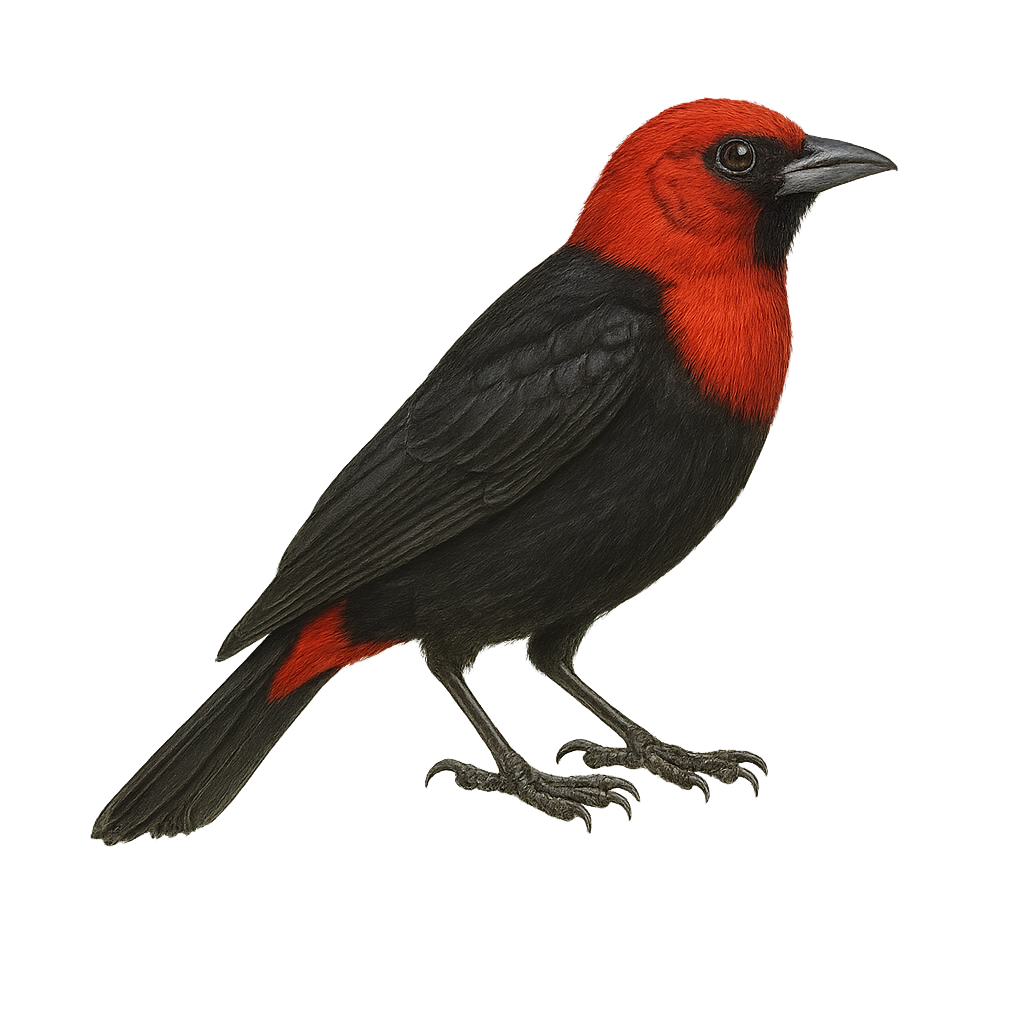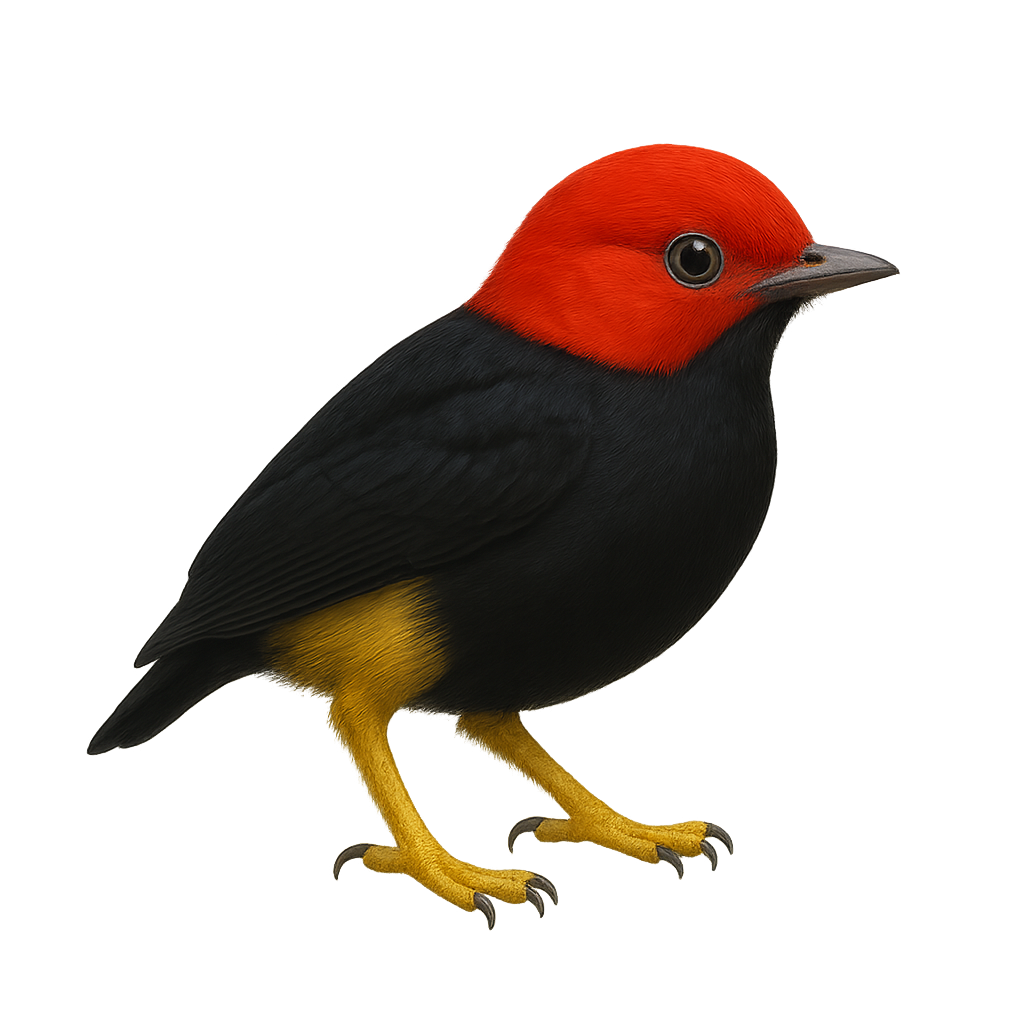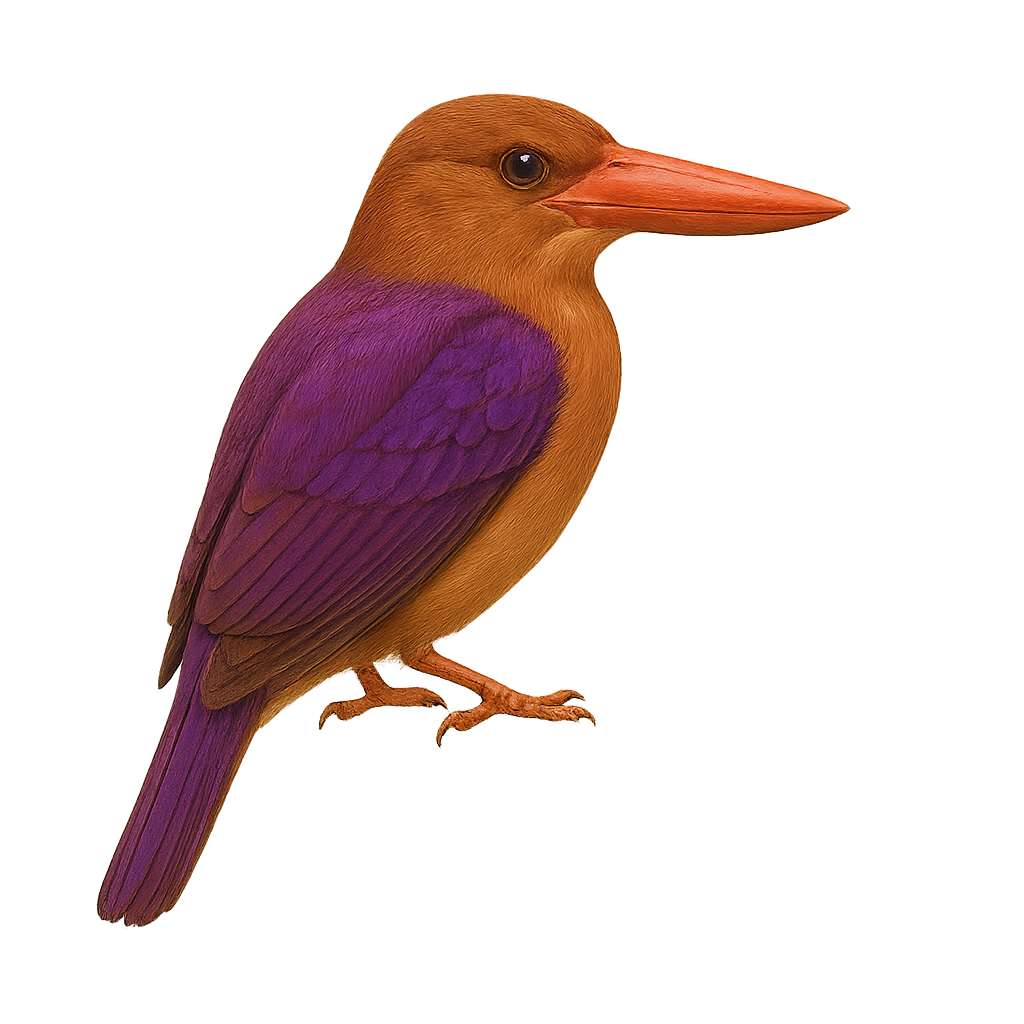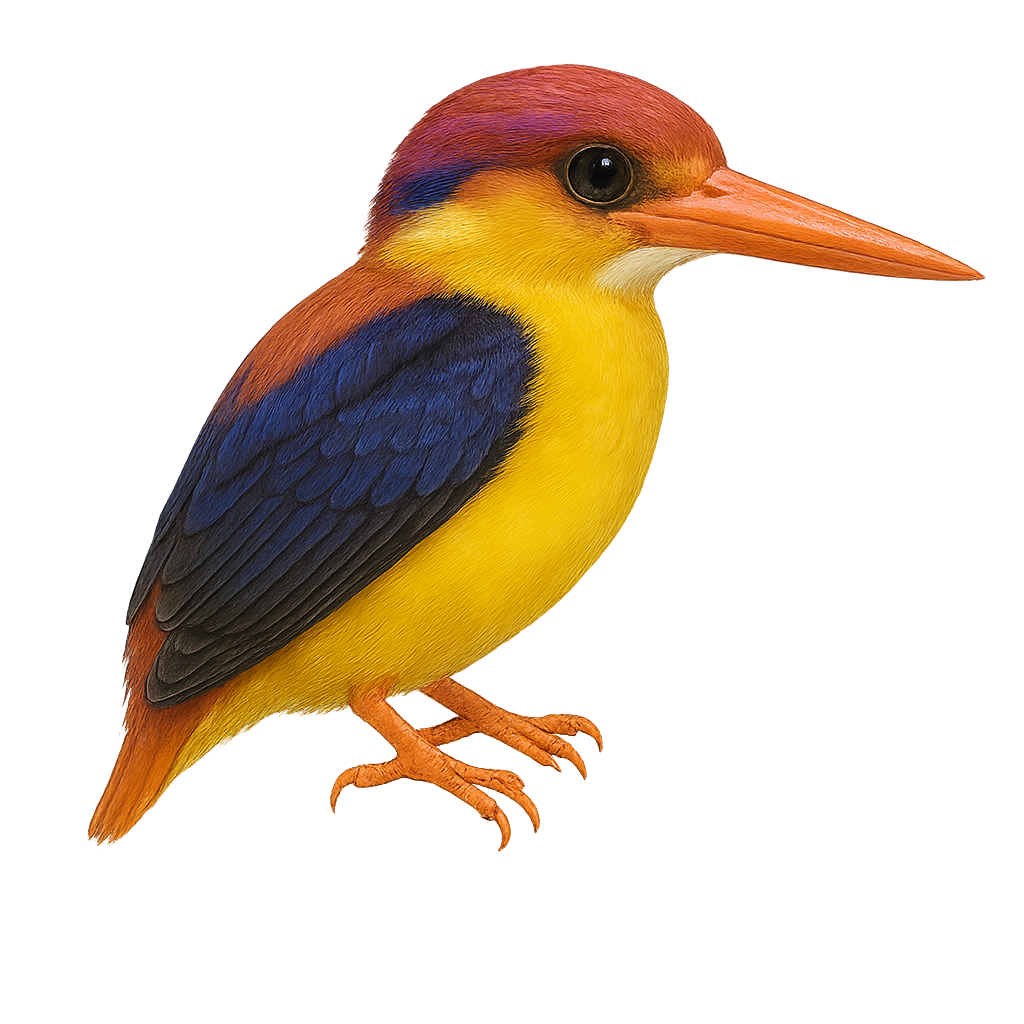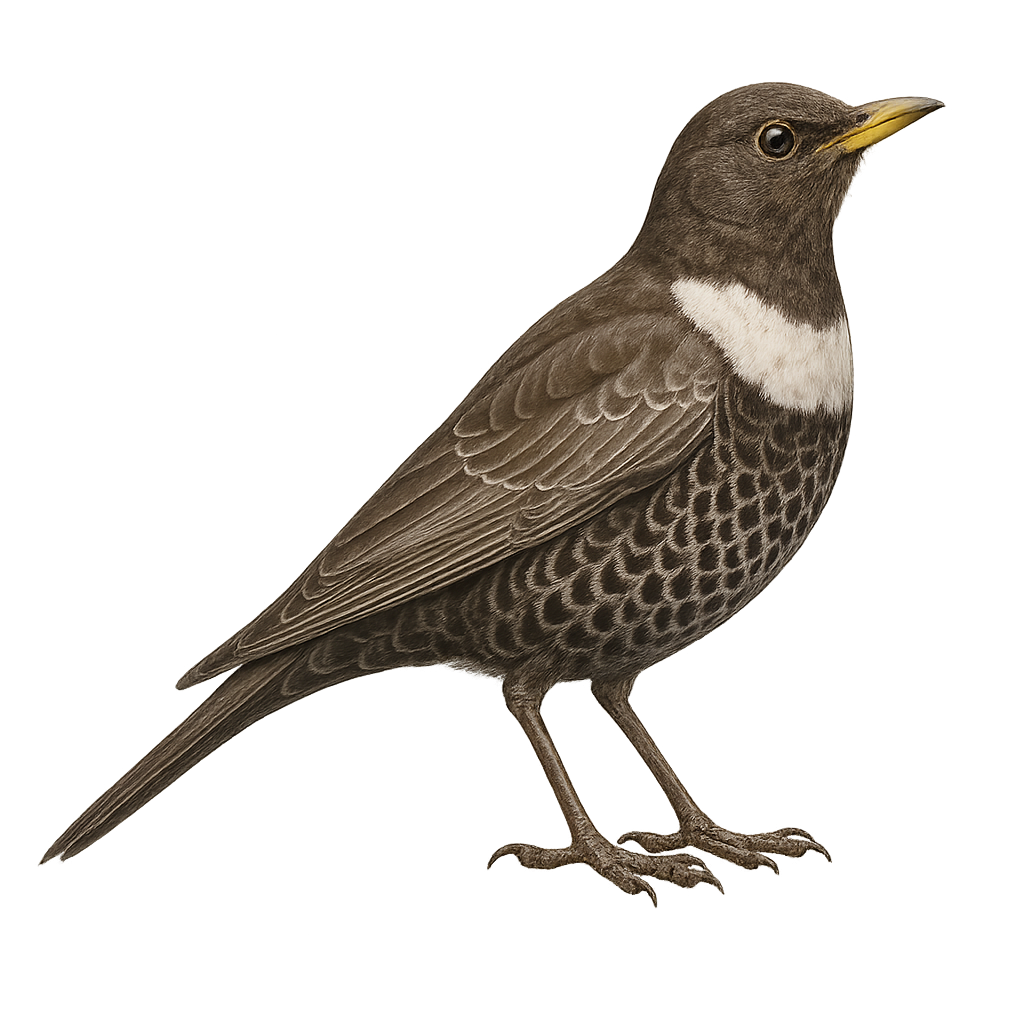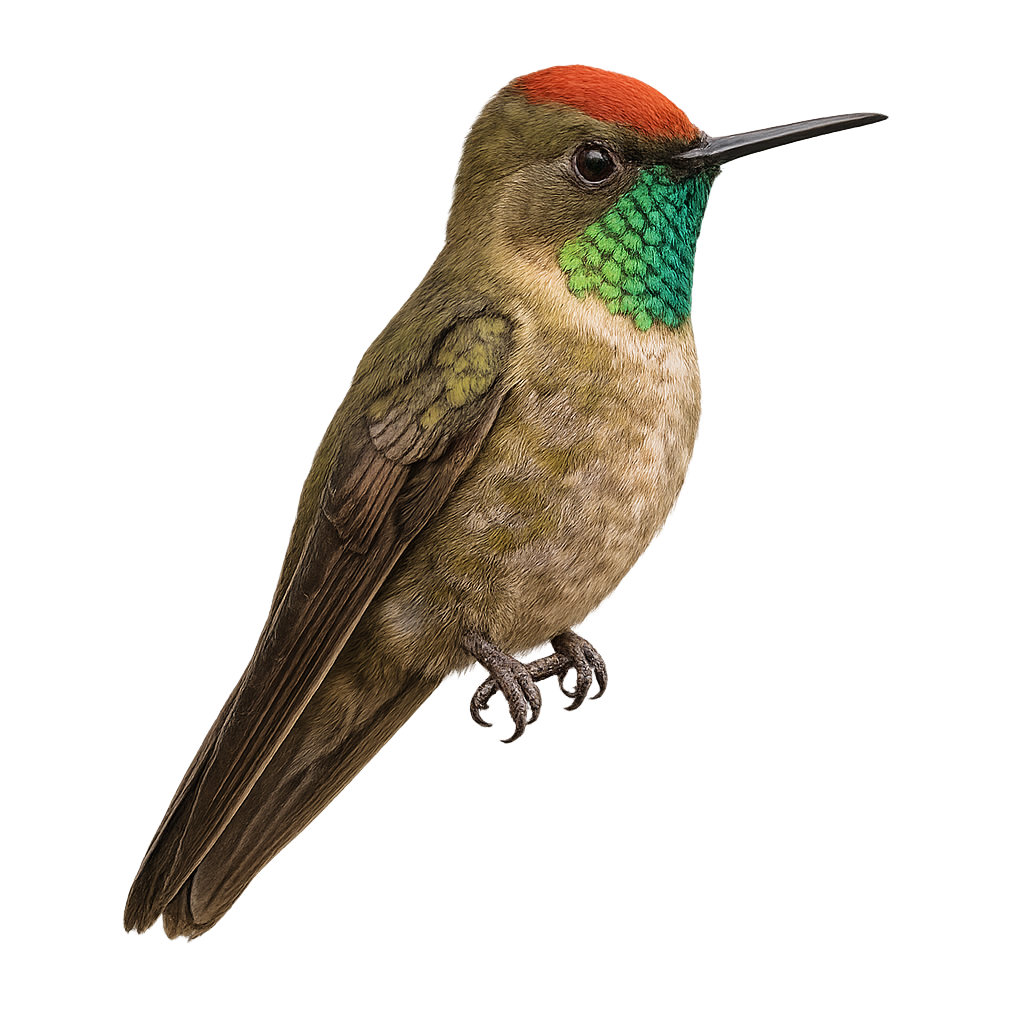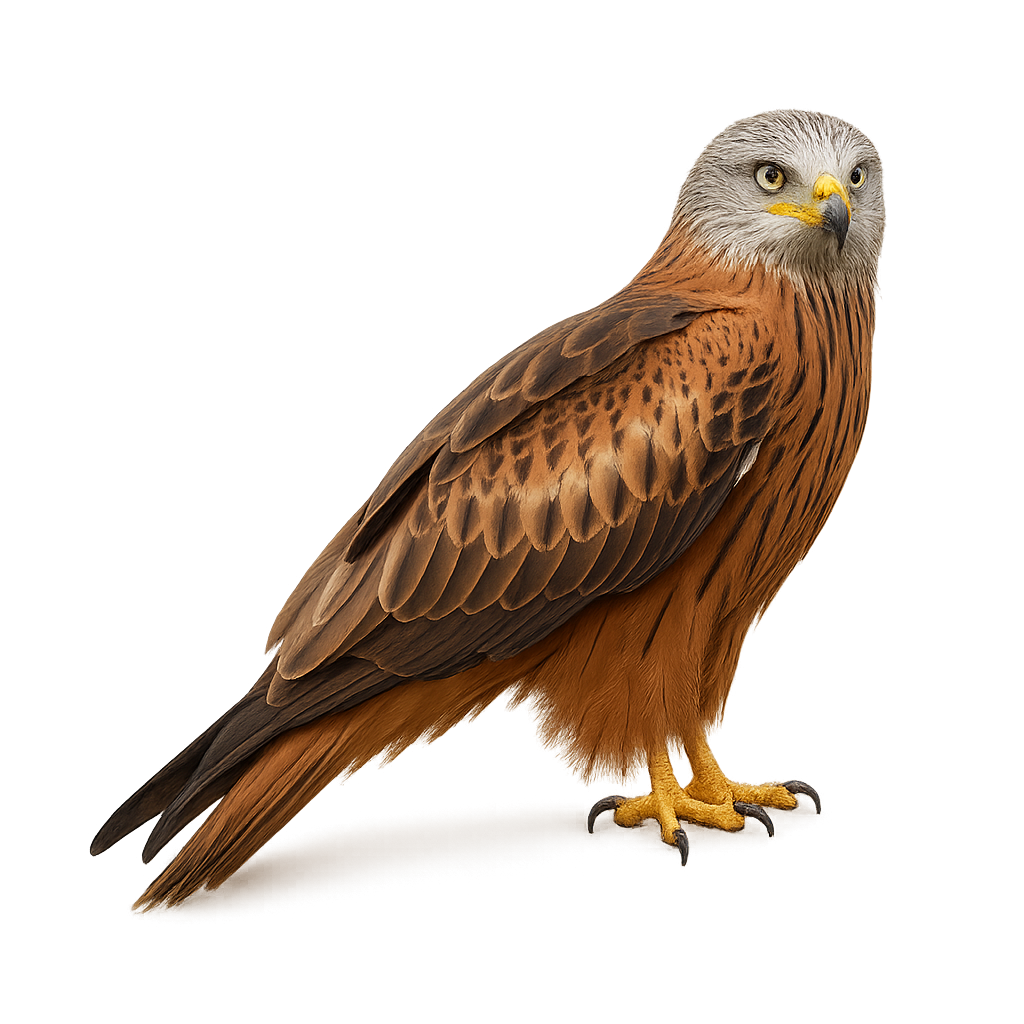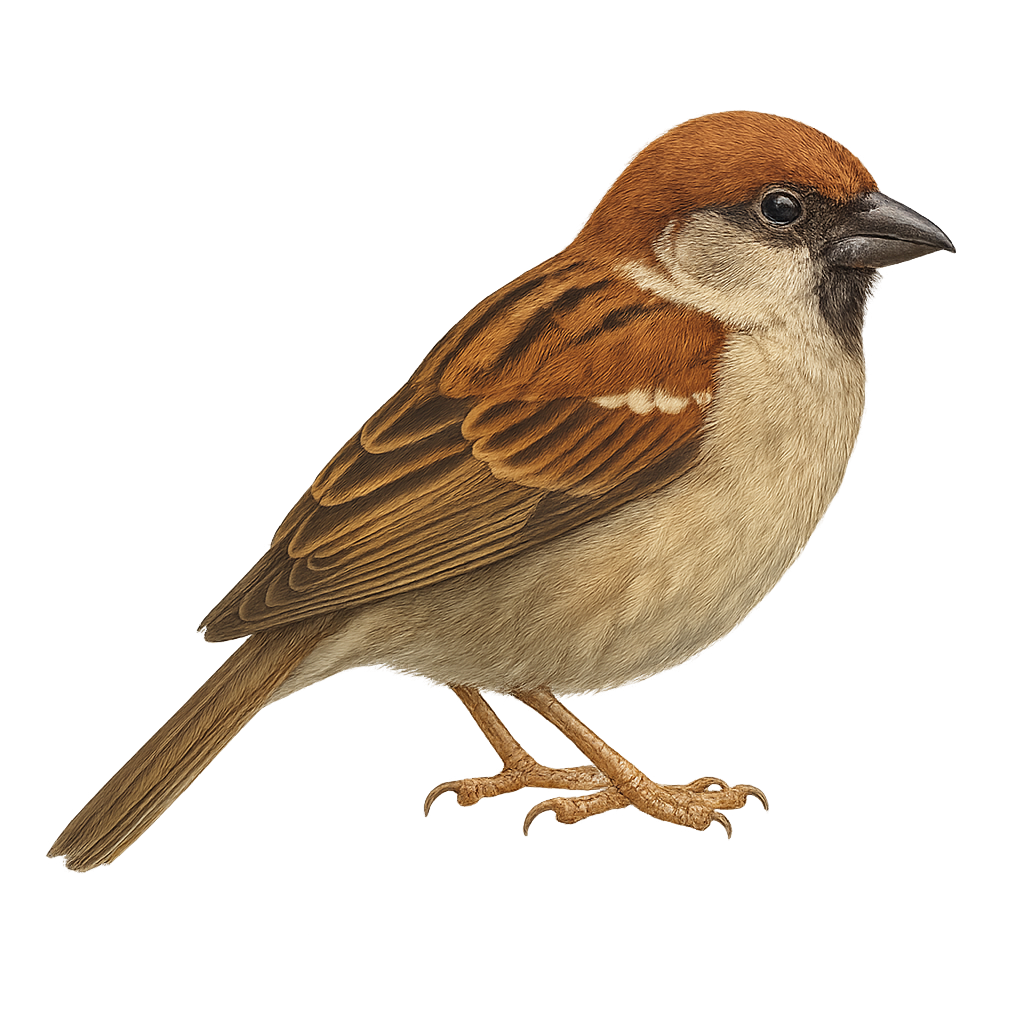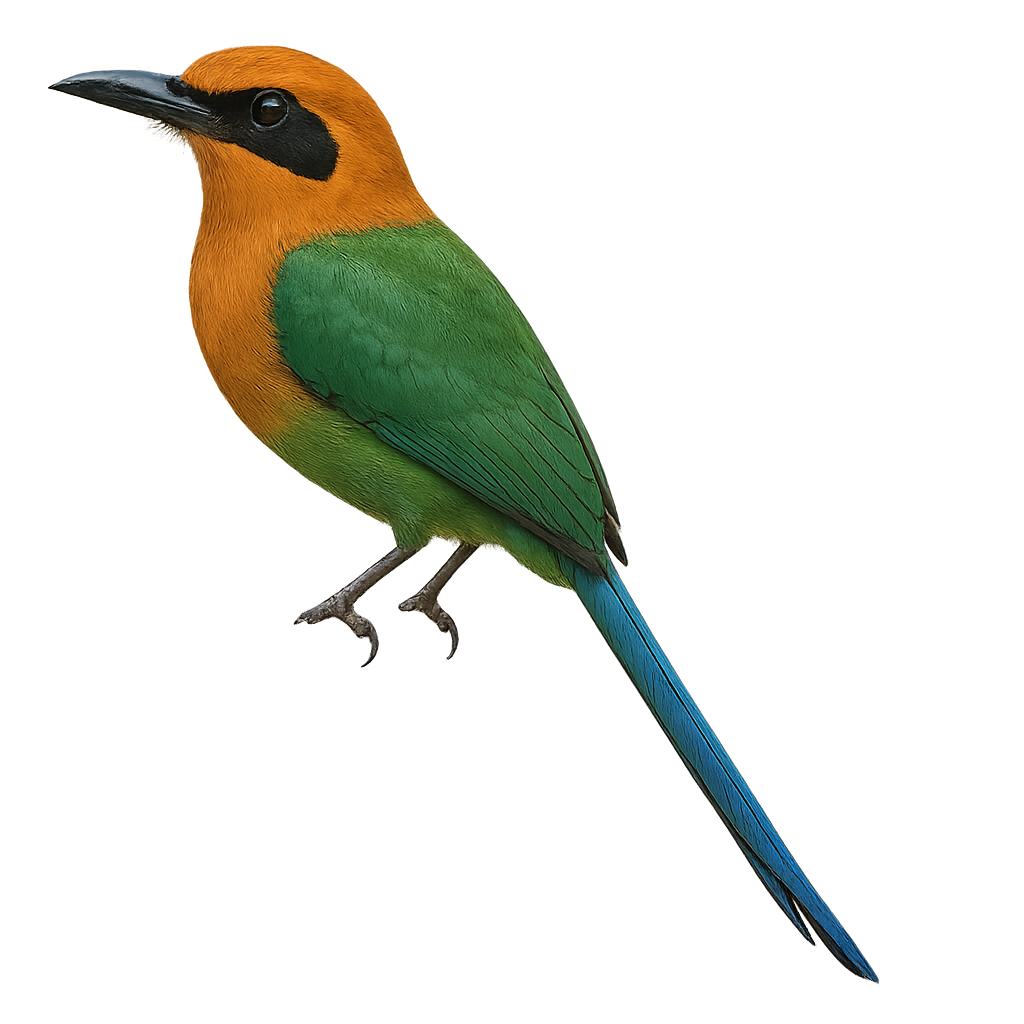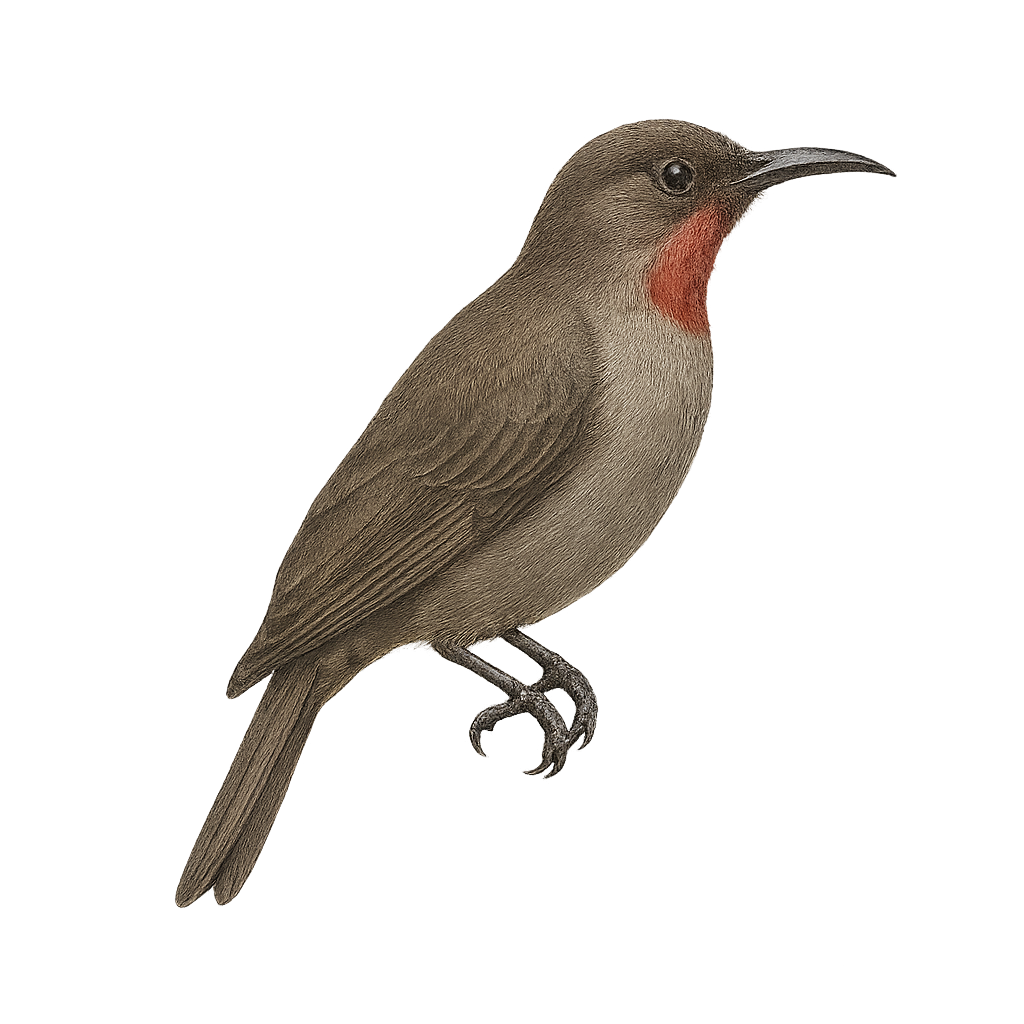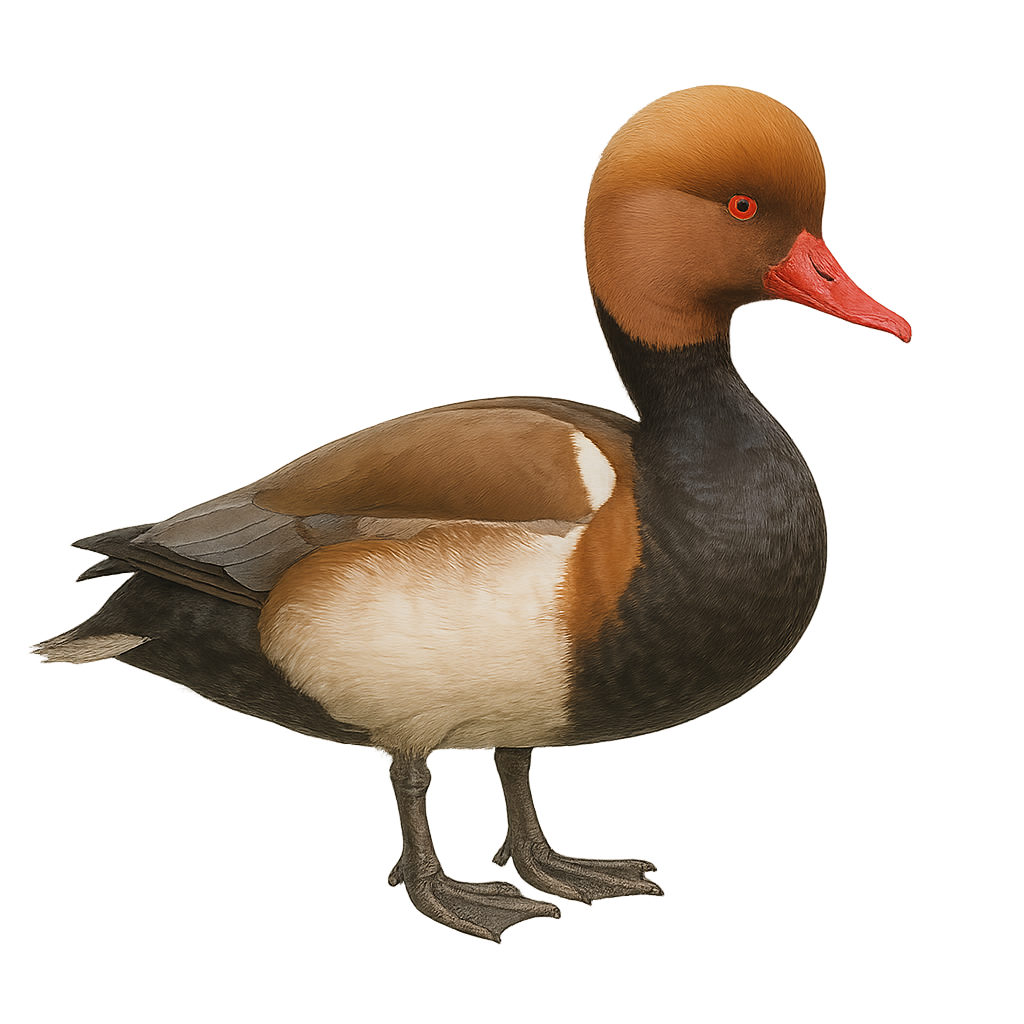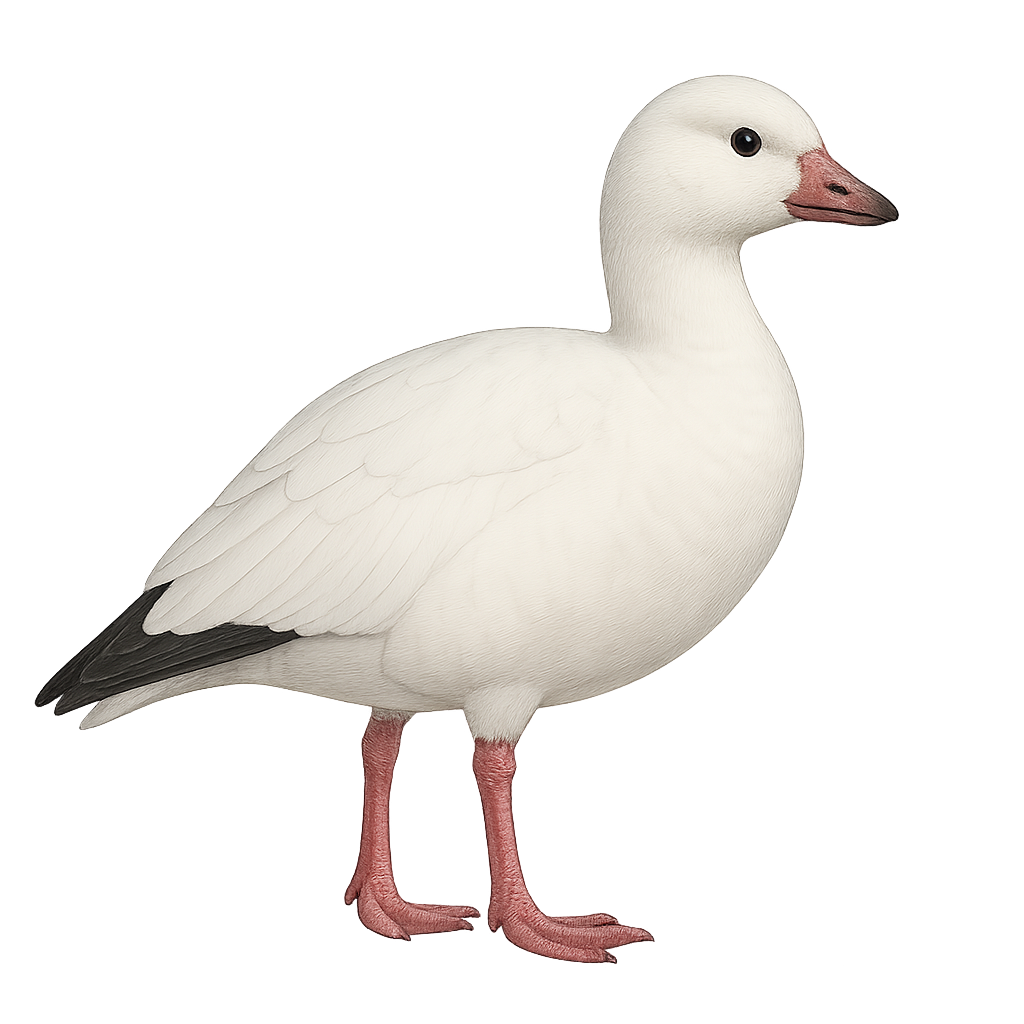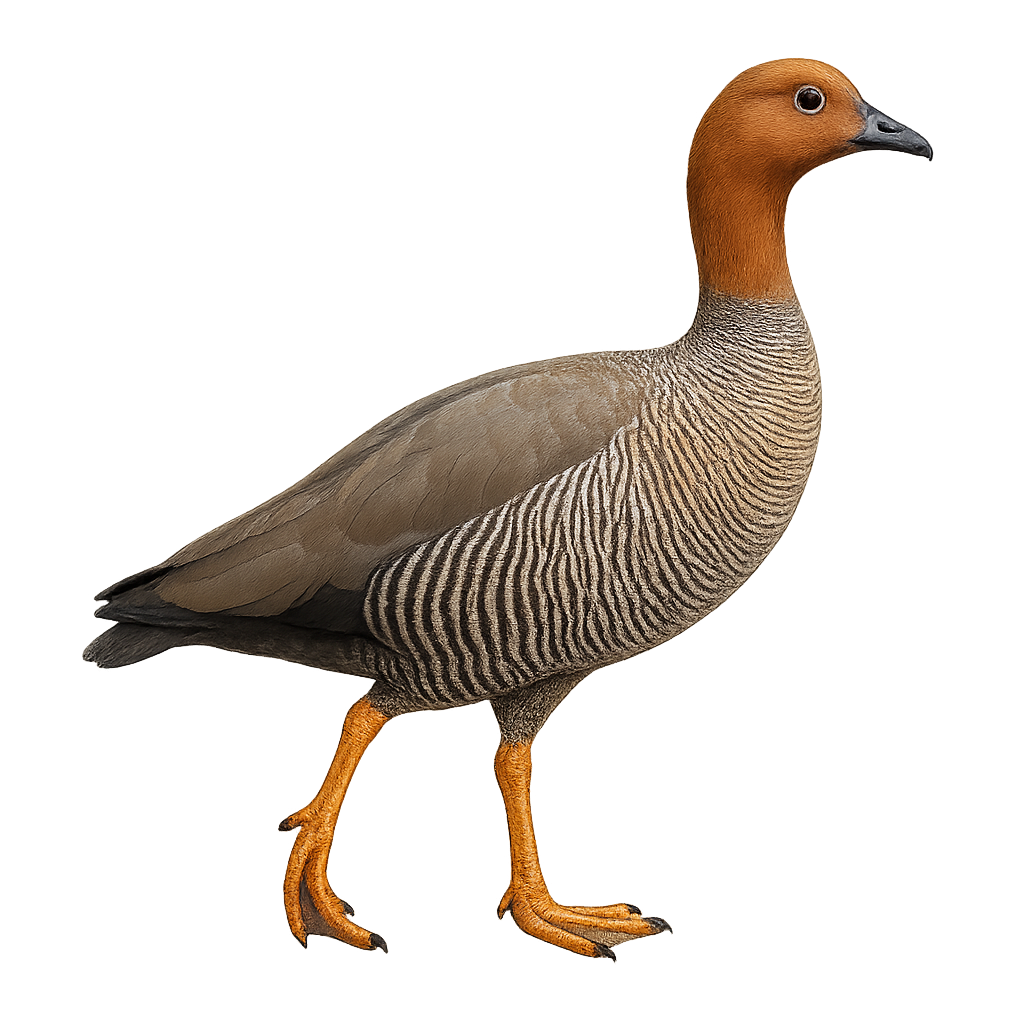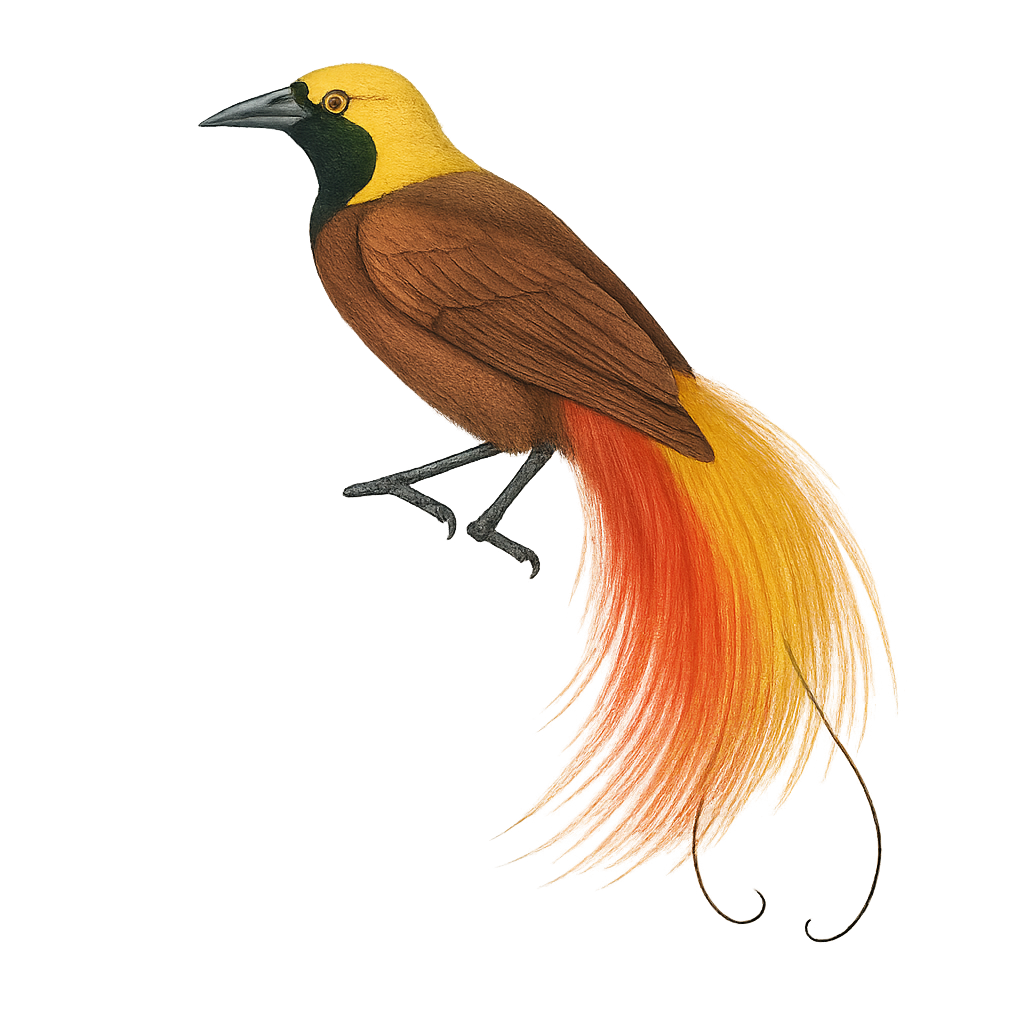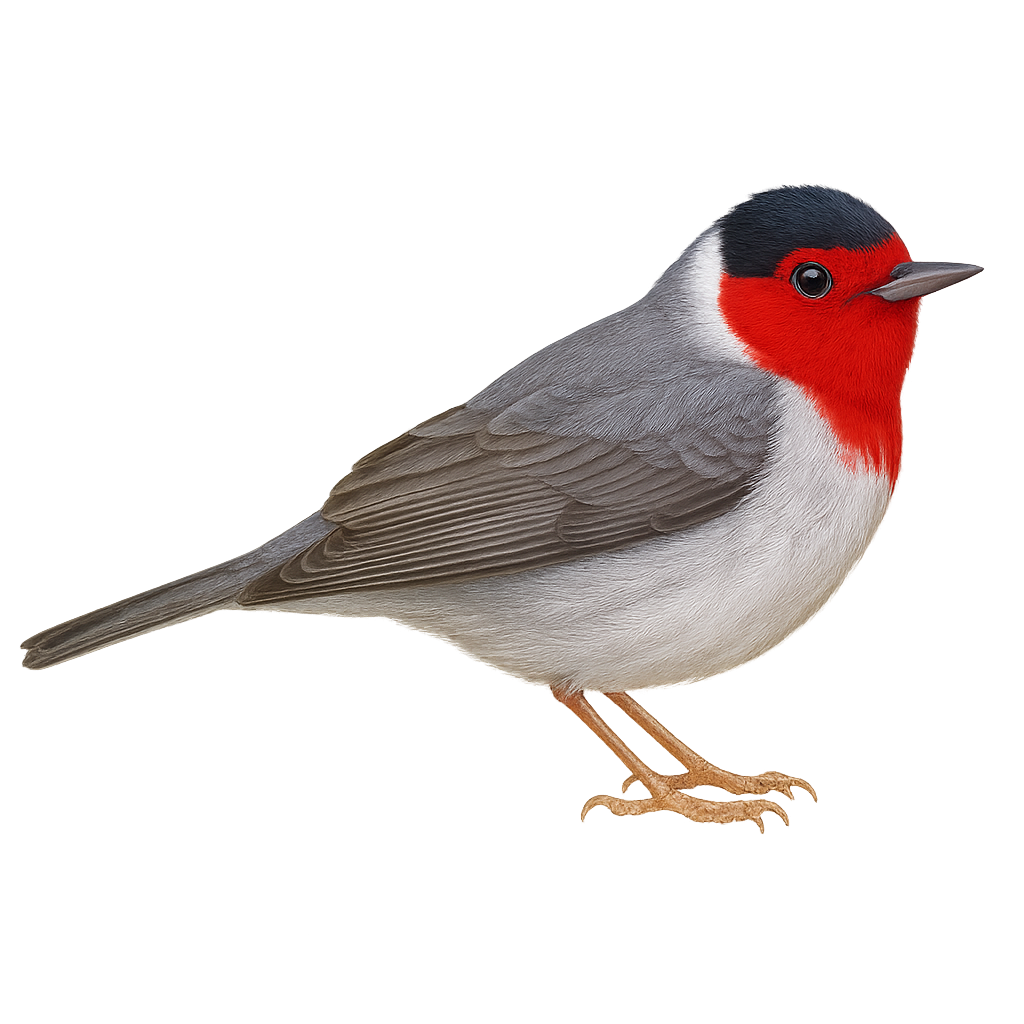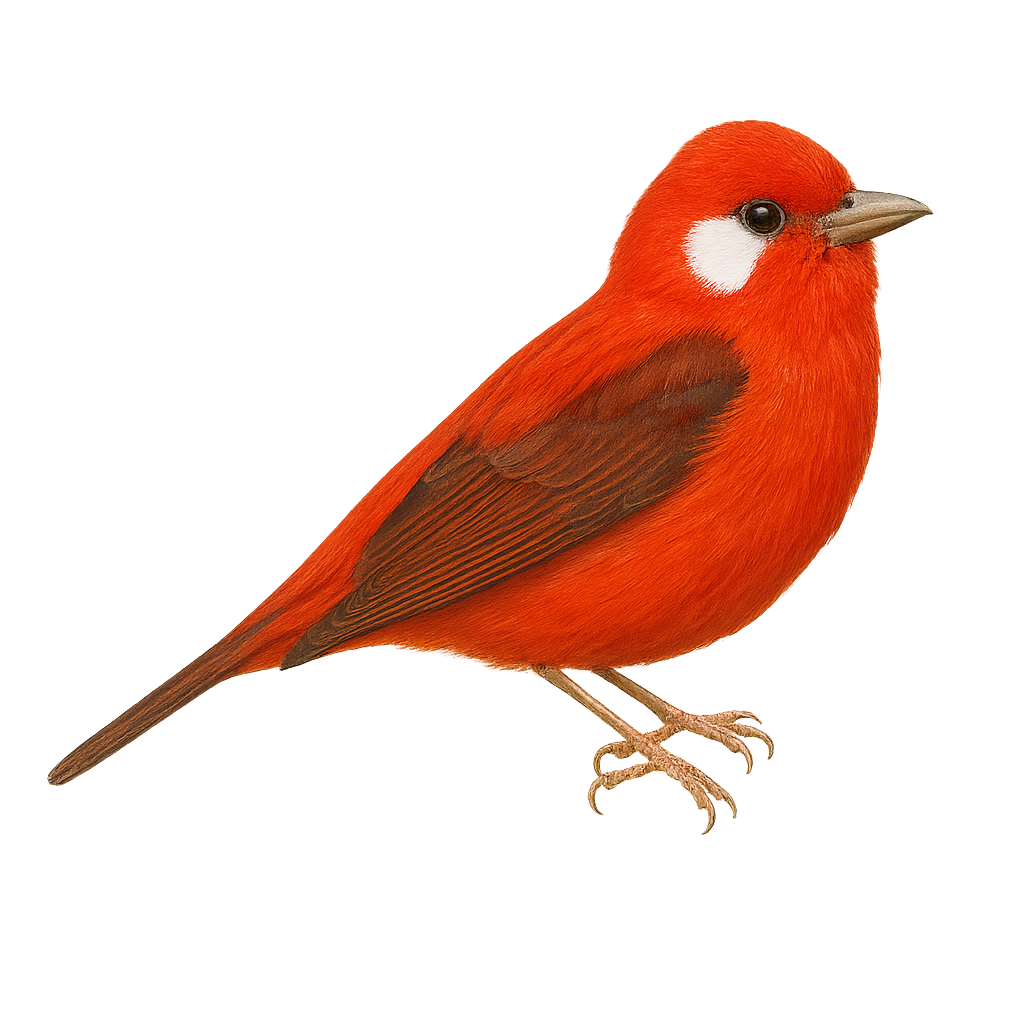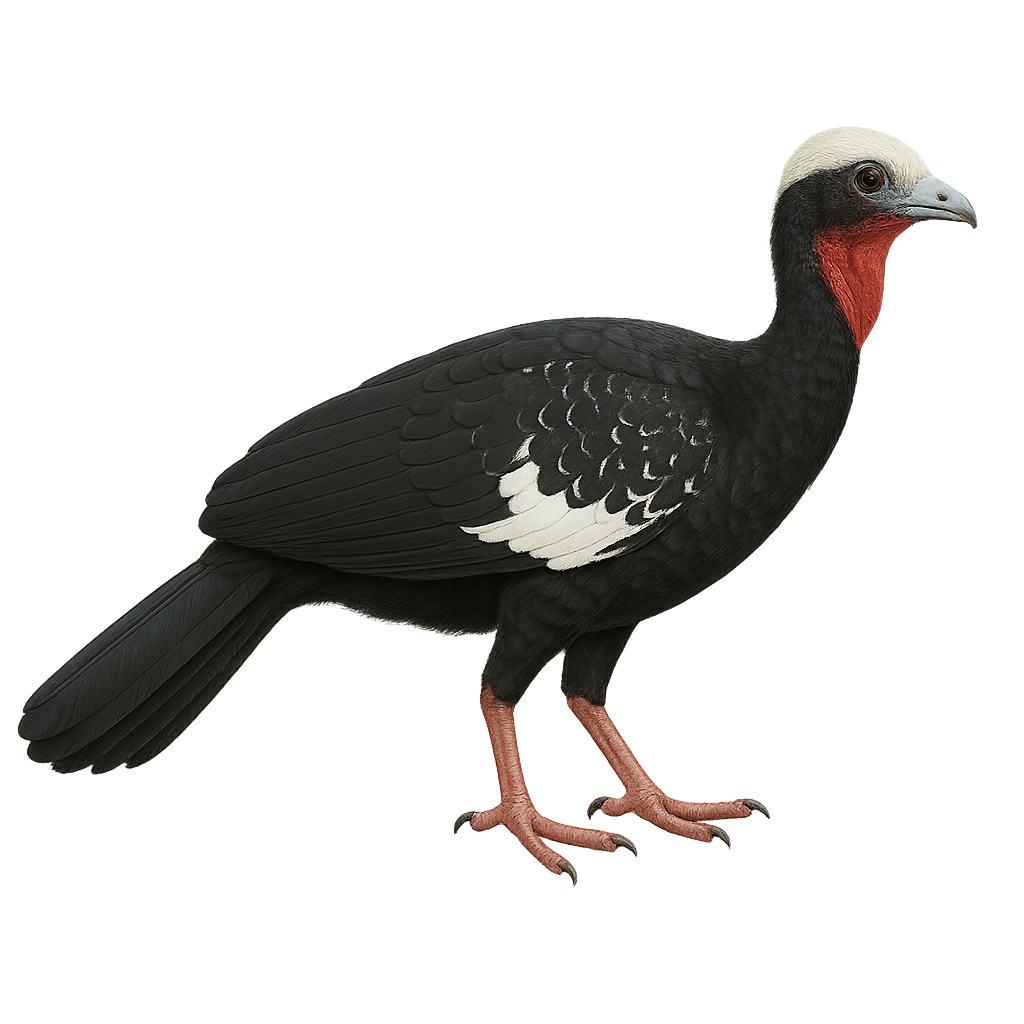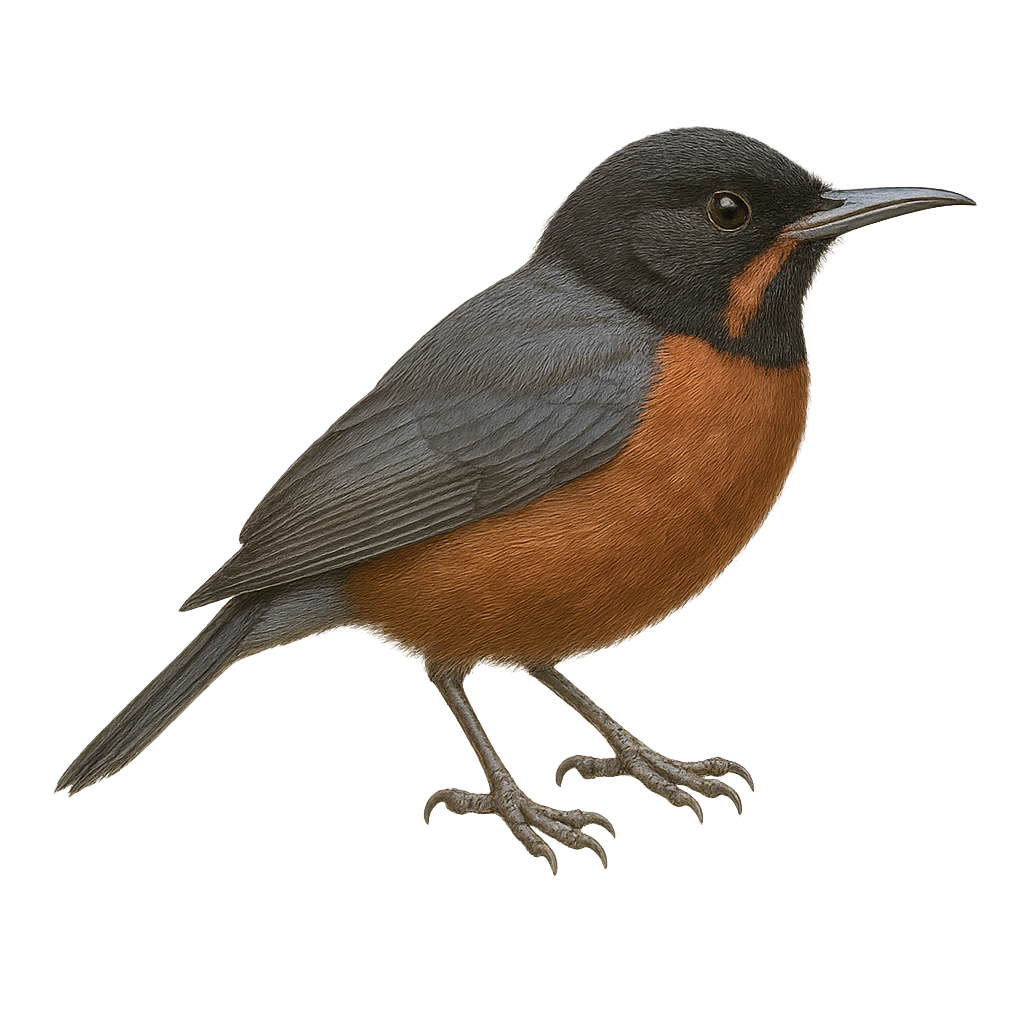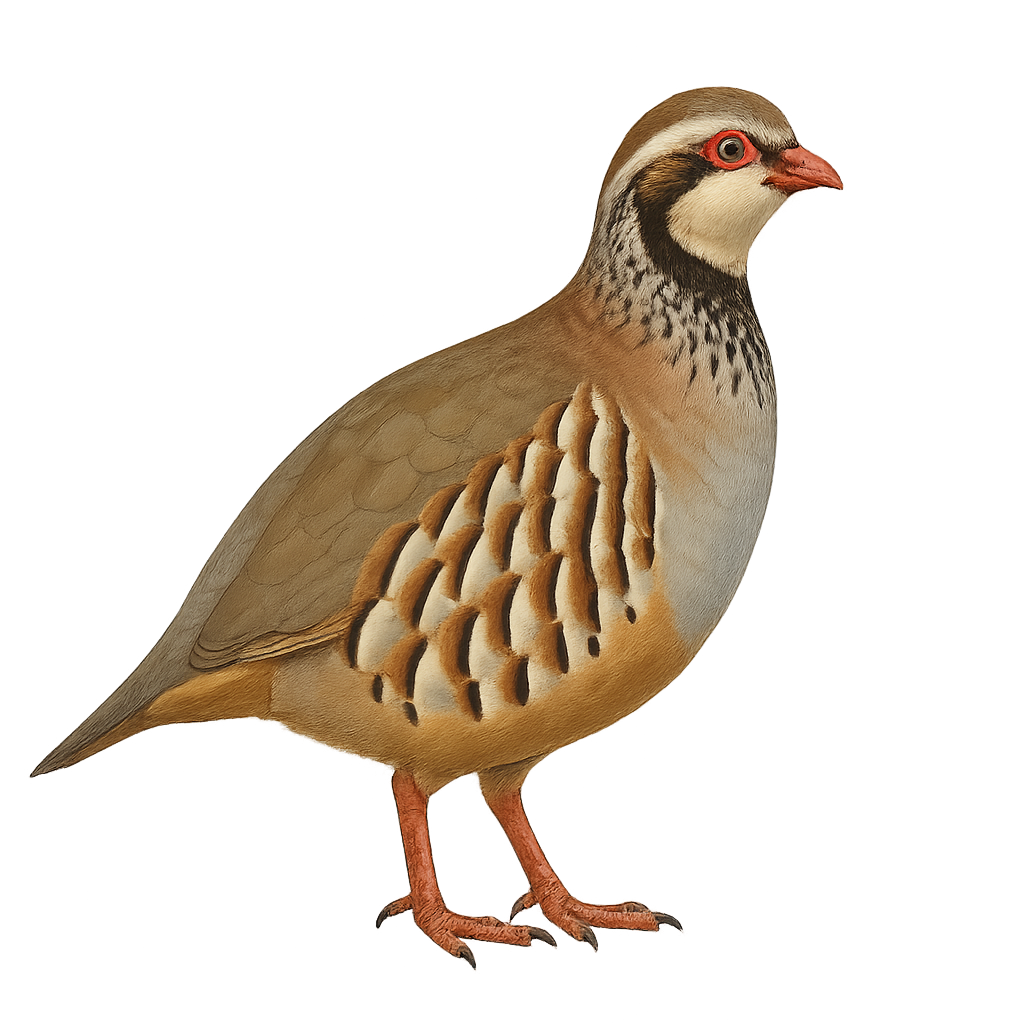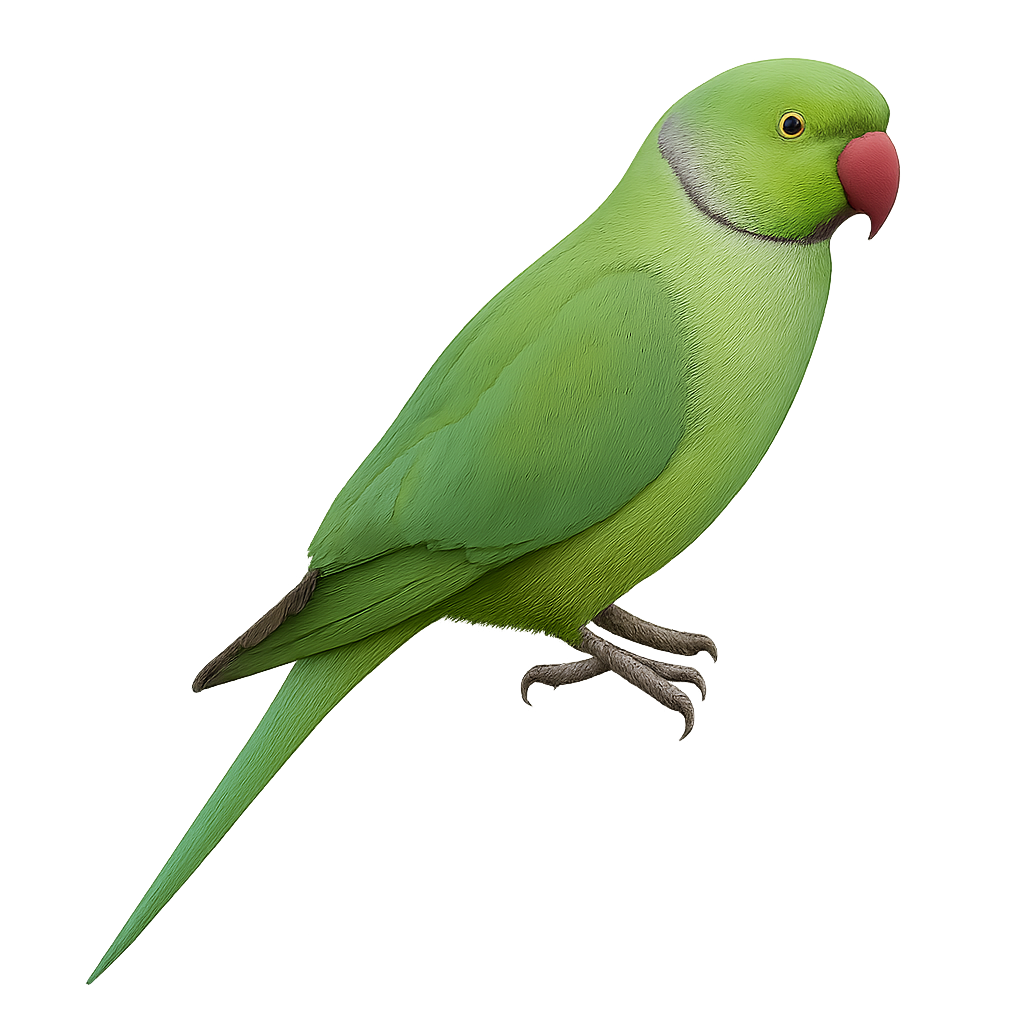The Red-and-blue Lory, or Mesitornis variegatus, is a vibrant and fascinating bird endemic to the Talaud and Sangihe Islands in Indonesia. This parrot boasts a striking plumage, predominantly red with shades of blue on its wings and tail. Its beak is a vivid orange, contrasting with its dark, expressive eyes. Measuring about 30 cm in length, it is known for its liveliness and intelligence. The Red-and-blue Lory primarily inhabits tropical rainforests, where it feeds on nectar, fruits, and flowers. Unfortunately, this species is critically endangered, mainly due to habitat loss and illegal trade in exotic birds.
The Red Lory, or Trichoglossus borneus, is a vibrant parrot native to the Moluccas in Indonesia. This lory is known for its striking red plumage, highlighted with blue and black on its wings and tail. Measuring about 30 cm in length, it has a strong, curved beak, perfect for feeding on nectar, fruits, and flowers. Sociable and noisy, it lives in groups and frequents tropical rainforests, mangroves, and plantations. Its flight is fast and direct, often accompanied by loud calls. Although popular in the pet trade, its wild population is threatened by deforestation and trapping.
The Rainbow Lorikeet, or Lorius lory, is a colorful parrot native to the tropical forests of New Guinea and surrounding islands. This stunning bird is distinguished by its vibrant plumage, blending shades of red, blue, green, and yellow. It measures about 25 to 30 cm in length and weighs between 130 and 200 grams. The Rainbow Lorikeet is known for its curved beak and brush-tipped tongue, adapted to its diet mainly consisting of nectar and fruits. Sociable and noisy, it often lives in groups and is renowned for its aerial acrobatics. Its ability to mimic sounds also makes it a popular bird in captivity.
The Rainbow Lorikeet, or Trichoglossus moluccanus, is a vibrant and dynamic bird native to Australia and surrounding islands. It is easily recognizable by its bright plumage, which includes shades of blue, green, red, and yellow. This medium-sized parrot measures about 25 to 30 cm in length and weighs between 75 and 157 grams. Known for its curved beak and brush-tipped tongue, it primarily feeds on nectar and pollen. Sociable and noisy, it often lives in groups and is very active, swiftly moving from tree to tree. The Rainbow Lorikeet is also appreciated for its ability to mimic sounds and interact with humans.
The Rhinoceros Auklet, or Cerorhinca monocerata, is a medium-sized seabird belonging to the Alcidae family. It is recognizable by its thick, colorful beak adorned with a horn-like extension, giving it its name. This bird features dark gray plumage on its back and white on its belly, with white-ringed eyes. It primarily inhabits the coastal waters of the North Pacific, from California to Japan. The Rhinoceros Auklet is an excellent diver, capable of descending several tens of meters to capture fish and invertebrates. It nests in colonies on rocky islands, digging burrows to lay a single egg. Although its conservation status is currently of least concern, it remains vulnerable to human disturbances and climate change.
The Red-shouldered Malimbe, scientifically known as Malimbus scutatus, is a bird from the Ploceidae family, predominantly found in the humid tropical forests of West Africa. This bird is notable for its glossy black plumage and striking red shoulders, giving it an elegant appearance. It is often seen in small groups, feeding mainly on insects and fruits. Its song is melodious, consisting of whistles and trills. Although its habitat is threatened by deforestation, it remains relatively common in protected areas.
The Red-capped Manakin, Pipra mentalis, is a small, brightly colored bird found in the tropical forests of Central America. Males are particularly recognizable by their vivid red heads contrasting with their black bodies, while females have more subdued green plumage. These birds are famous for their spectacular courtship displays, where males perform complex dances to attract females. They primarily inhabit the understory of humid forests, feeding on fruits and insects. Although relatively common within their range, their habitat is threatened by deforestation. They are generally suspicious, making observation challenging.
The Ruddy Kingfisher, or Halcyon coromanda, is a medium-sized bird known for its striking purple plumage and robust red bill. It primarily inhabits the tropical and subtropical forests of Southeast Asia, where it feeds on small fish, insects, and crustaceans. This bird is often seen near water bodies, using its keen eyesight to spot prey. Although generally discreet, its melodious call can be heard at dawn and dusk. The Ruddy Kingfisher is a migratory bird, moving to warmer regions during winter months. Its population is stable, but it remains vulnerable to deforestation.
The Rufous-backed Dwarf Kingfisher, Ceyx rufidorsa, is a small, vibrantly colored bird found in the tropical forests of Southeast Asia. It is easily recognizable by its bright red back and wings tinged with shades of blue and purple. This kingfisher measures about 13 cm in length and weighs between 14 and 17 grams. It primarily inhabits dense forests near water bodies, where it hunts small fish, insects, and crustaceans. Its hunting technique is impressive, diving swiftly into the water to catch its prey. Although discreet, its high-pitched, repetitive call can be heard through the canopy.
The Red-backed Fairywren is a small passerine bird endemic to Australia, belonging to the Maluridae family. It is easily recognizable by its distinctive plumage: the male sports a bright red back and a black head during the breeding season, while the female and juveniles have more subdued brown plumage. This small bird measures about 11 to 13 cm in length and weighs between 5 and 10 grams. It primarily inhabits savannas, grasslands, and open shrublands. The Red-backed Fairywren is a social bird, often seen in small groups. It feeds mainly on insects and small invertebrates, which it captures by nimbly hopping among grasses and bushes.
The ring ouzel is a passerine bird found primarily in the mountains and coniferous forests of Europe, Asia, and the Middle East. It is easily recognized by its dark plumage, white chest that contrasts with its black belly, and the white ring around its neck. This small bird primarily feeds on berries, insects, and small fruits, which it finds mainly in bushes and forest floors.
The Chalcostigma ruficeps, or Rufous-capped Thornbill, is a captivating small bird belonging to the Trochilidae family. This hummingbird is notable for its distinctive rufous head, contrasting with its metallic green body. It primarily inhabits cloud forests and shrublands of the Andes, at altitudes between 2500 and 4000 meters. Its modest size, about 10 cm, and light weight, around 5 grams, allow it to maneuver skillfully among the flowers it feeds on. Its thin, slightly curved bill is perfectly adapted to extract nectar from tubular flowers. In addition to its nectarivorous diet, it also consumes small insects to meet its protein needs.
The Red Kite is a large bird of prey, measuring about 60 to 70 cm in length, with a wingspan of 1.5 to 1.8 meters. It typically weighs between 1.2 and 1.5 kg. This raptor is distinguished by its reddish-brown plumage on the back and wings, with a lighter head and a deeply forked tail, giving it a characteristic silhouette in flight. The Red Kite primarily inhabits open forests, agricultural areas, and meadows, where it hunts small mammals, birds, insects, and carrion. It is an excellent glider and uses thermal currents to stay aloft effortlessly, allowing it to spot prey from a distance. The Red Kite is also a social bird, often seen in groups during the migration period, although it is generally solitary outside this time. While its population remains relatively stable, it faces threats such as habitat loss, pollution, and collisions with power lines.
The Russet Sparrow, or Passer cinnamomeus, is a small passerine bird belonging to the family Passeridae. It is primarily found in Asia, especially in the mountainous regions of the Himalayas, southern China, and Japan. This sparrow is distinguished by its reddish-brown plumage on the back and wings, contrasting with a lighter belly. Males often sport a gray cap and a black throat, while females have duller colors. Adapted to rural and semi-urban areas, it thrives in human-modified environments. It primarily feeds on seeds, insects, and small fruits. Although its song is discreet, it is often seen in small groups, especially outside the breeding season.
The Russet-crowned Motmot, or Momotus mexicanus, is a colorful bird endemic to western Mexico. It is easily recognized by its rich russet-colored head, black facial mask, green back, blue-green underparts, and its distinctive racket-shaped central tail feathers. It inhabits dry forests, scrublands, and open woodlands, often near ravines or rivers. Usually shy but approachable, it often perches quietly on low branches. Its diet includes insects, small vertebrates, and fruits. The species is locally common and not currently threatened.
The Rufous-capped Motmot, scientifically known as Baryphthengus ruficapillus, is a captivating bird from the Momotidae family. It is easily identified by its distinctive rufous head and vibrant green plumage. This bird primarily inhabits the humid tropical forests of Central and South America, where it feeds on insects, small reptiles, and fruits. Often seen perched quietly on a branch, it swings its racket-shaped tail from side to side. Although generally discreet, its melodious call can be heard through the dense canopy. The Rufous-capped Motmot plays a crucial role in its ecosystem as both a predator of insects and a seed disperser.
The Rufous Motmot is a medium-sized tropical bird, measuring between 38 and 43 cm in length. It is identifiable by its bright blue crown bordered by a black band, green back, and rufous chest. Its long tail ends with two racket-shaped feathers, characteristic of the genus. Found in the humid forests of Central and South America, it frequents forest edges and open woodlands. Omnivorous, it feeds on insects, small vertebrates, and fruits. It nests in tunnels dug into banks or slopes, where the female typically lays 3 to 4 white eggs. Although currently listed as Least Concern, deforestation poses a threat to its natural habitats.
The Red Myzomela, or Myzomela eques, is a small bird with striking bright red plumage, accented by black on its wings and tail. This nectarivore is often found in tropical rainforests, mangroves, and flower gardens, feeding primarily on nectar but also on insects. Its slender, curved beak is perfectly adapted to reach the nectar of flowers. Known for its melodious song and agile movements among branches, it is generally solitary but can sometimes be seen in small groups, especially during the breeding season. Its adaptability to various habitats makes it a resilient species in the face of environmental changes.
The Red-crested Pochard is a medium-sized diving duck, measuring between 53 and 58 cm in length with a wingspan of 84 to 88 cm. The male is notable for its rounded, bright reddish-orange head, vivid red bill, black chest, and white flanks. The female is more subdued, with brown plumage, pale cheeks, and a dark bill. This species inhabits eutrophic lakes and ponds rich in aquatic vegetation, often bordered by reed beds. It primarily feeds on aquatic plants like pondweeds and charophytes, but also consumes aquatic invertebrates, including mollusks and insects. Migratory, the Red-crested Pochard winters around the Mediterranean and the Black Sea. Although listed as Least Concern by the IUCN, it is sensitive to the degradation of wetlands.
The Ross's Goose is a small-sized species, characterized by its pure white plumage and short pink bill. It stands out due to its compact size and elegant demeanor. Adults display a uniform coloration, while juveniles have grayer tones. This migratory species is mainly observed in North America, nesting in Arctic regions and migrating south for winter. It frequents wetlands, lakes, and flooded meadows. Although its conservation status is currently stable, it remains vulnerable to climate change and habitat loss.
The Rufescent Tiger Heron, Tigrisoma lineatum, is a medium-sized heron known for its distinctive striped plumage of brown and white. It primarily inhabits the wetlands of South America, including marshes, rivers, and lakes. This heron prefers dense habitats where it can easily camouflage. It feeds mainly on fish, frogs, and aquatic insects, using its still and patient hunting technique. The Rufescent Tiger Heron is a solitary bird, often seen alone or in pairs, and is known for its deep, hoarse call. Its breeding season varies by region but is generally linked to the rainy season.
The Ruddy-headed Goose, or Chloephaga rubidiceps, is a bird species belonging to the Anatidae family. It is characterized by its reddish head and neck, contrasting with its grey body and black and white wings. This bird is mainly found in Patagonia, where it inhabits open grasslands and wetlands. Although it appears robust, it is relatively small compared to other goose species. Males and females are similar in appearance, with males being slightly larger. The Ruddy-headed Goose is known for its seasonal migrations, moving northward in winter. It primarily feeds on grasses and aquatic plants. Unfortunately, this species is threatened by habitat loss and predation by introduced species.
The Raggiana Bird-of-paradise, or Paradisaea raggiana, is an iconic bird of the Paradisaeidae family, endemic to Papua New Guinea. It is renowned for its spectacular plumage, especially in males, who display bright red and orange feathers, along with elongated central plumes. These birds are famous for their impressive courtship displays, where males perform complex dances to attract females. They primarily inhabit tropical rainforests, feeding on fruits, insects, and small animals. Their melodious song and complex social behaviors make them a fascinating subject for ornithologists. Although their habitat is threatened by deforestation, they remain relatively common within their range.
The Republican Paradise-flycatcher is a small bird native to the lowland forests of Sulawesi Island in Indonesia. It measures about 20 cm in length, with a long tail that can reach up to 15 cm, and weighs between 25 and 30 g. What distinguishes the Republican Paradise-flycatcher is its bright coloration, with vivid green, blue, and red feathers and a magnificent crest shaped like a veil. The male, in particular, displays extravagant feathers during courtship displays to attract females. This bird primarily feeds on fruits, seeds, and insects. Although the Republican Paradise-flycatcher is not in immediate danger, deforestation and hunting pose potential threats to its natural habitat.
The Red-faced Warbler, or Cardellina rubrifrons, is a small, brightly colored songbird primarily found in the coniferous forests of the southwestern United States and Mexico. This passerine is notable for its vivid red face, contrasting with its gray back and white belly. It is often seen foraging for insects in dense foliage, moving with agility and speed. Although its song is subtle, it is recognizable by its melodic trills. The Red-faced Warbler is a migratory bird, spending its winters in the warmer regions of Mexico. Its population is stable, though deforestation poses a potential threat to its natural habitat.
The Red Warbler, scientifically known as Cardellina rubra, is a small songbird endemic to the mountainous forests of Mexico. It is notable for its bright red plumage, contrasting with its black face and slightly darker wings. Measuring about 12 to 13 cm in length, it is often seen actively moving through foliage in search of insects and small invertebrates. Its melodious and varied song is a distinctive feature, often used to mark territory or attract a mate. The Red Warbler prefers pine and oak forests at high altitudes, where it finds an ideal habitat for breeding and feeding.
The Red-throated Piping Guan, known scientifically as Pipile cujubi, is a medium-sized bird native to the tropical rainforests of South America, particularly in Brazil and Bolivia. It measures about 70 cm in length and is easily identified by its glossy black plumage and striking red throat. This bird primarily feeds on fruits, seeds, and insects. Often seen in small groups, the Red-throated Piping Guan moves gracefully through the canopy. Despite habitat loss due to deforestation, it remains relatively common in certain areas. Its vocalizations consist of a mix of whistles and coos, often heard at dawn.
The Rusty Flowerpiercer is a small passerine bird belonging to the Thraupidae family. It is primarily found in the mountainous regions of the Andes, where it inhabits humid forests and scrublands. Its plumage is characterized by a brownish coloration on the belly, contrasting with darker shades on the back and wings. This bird is known for its thin, curved beak, adapted to its flower-piercing technique to access nectar. Although often solitary, it can be seen in small groups when foraging. Its song is discreet but plays a crucial role in communication among individuals.
The Red-legged Partridge is a medium-sized galliform bird, about 33 cm in length. It features a reddish-brown back, bluish-grey chest, and flanks striped with black and white. Its white throat is bordered by a black horseshoe-shaped collar, and it has red legs and beak. Native to southwestern Europe, it inhabits dry open areas, scrubby hills, farmlands, and fallow fields. Non-migratory and ground-dwelling, it prefers running to flying when disturbed. Its diet mainly consists of seeds, young shoots, and insects, the latter being crucial for chicks. Although listed as Least Concern by the IUCN, the Red-legged Partridge is declining in some areas due to habitat loss, overhunting, and hybridization with introduced farm-reared birds.
Psittacula krameri, the rose-ringed parakeet, is a parrot 38–40 cm in length with bright green plumage, a distinctive pink neck ring in adult males, and a red–orange bill. Native to South Asia, it occupies parks, orchards, agricultural lands, and urban environments, feeding on seeds, fruits, and flowers. Social and vocal, it nests in tree cavities and may switch mates within the same breeding season.


